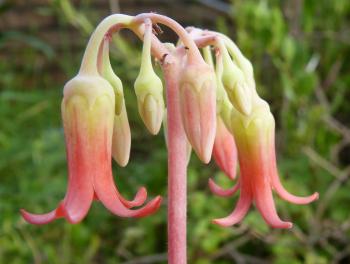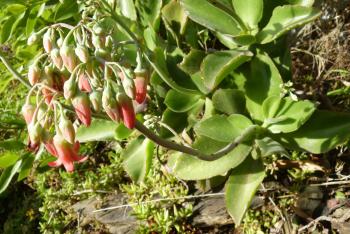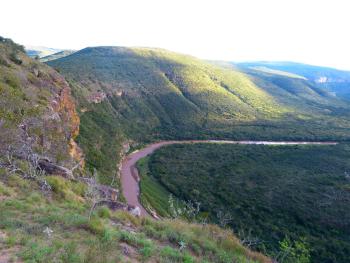Cotyledon petiolaris
Cotyledon petiolaris Van Jaarsv.
Family: Crassulaceae
Common names: Kei-cotyledon (Eng.); Keiplakkie (Afr.)
Introduction
Cotyledon petiolaris is a shrubby leaf succulent with orange-red bell-shaped flowers during winter, attracting sunbirds. Its short petioles distinguish it from other cotyledons.

Description
Description
Ascending branched, leaf succulent shrub, up to 250–350 mm high. Roots are fibrous. Branches are ascending, 6–8 mm in diameter, at first green,becoming greyish brown and grey in older branches. Leaves are oblanceolate (rarely elliptical), 75–125 × 35–55 mm, green, firm and leathery; upper surface concave with dense short hairs; the margin reddish, leathery, sometimes undulating, continuous to the short petiole; the leaf tip is pointed or rounded and ending in a hard point. The leaf petiole is short, 8–10 mm long.

The inflorescence is an erect, branched panicle, 150–200 mm high, comprising 3–5 flowering branches. The inflorescence stalk is 200–250 mm high, covered in hairs similar to those on the leaves and with 1 pair of bracts, 2 × 1.5 mm, early deciduous. Calyx lobes 5, green, 2 × 2 mm. Corolla tubular, hanging, orange-red, 20–25 mm long, about 9–10 mm in diameter; tube 14–16 mm long, lobes free for 12–13 mm at apex (12 × 4 mm), longish spear-shaped, the tips recurved. Stamens 10–12 mm long, fused to base of corolla, in 2 whorls; anthers yellow, spherical, 1.3 mm long. Carpels tapering, 14–16 mm long. Flowering time is in winter.

Conservation Status
Status
This species was only described in 2015, and its Red List status has not yet been evaluated, but it is not threatened as it is well protected by its cliff-face habitat.
Distribution and habitat
Distribution description
Widespread along dry river valleys of the Eastern Cape, from Mtata River in the northeast to east of Port Alfred, in the south. The habitat consists of Eastern Valley Bushveld. Plants grow on rocky cliffs on various aspects.

Derivation of name and historical aspects
History
The plant was named by the author in Bradleya, in 2015. The name petiolaris meaning ‘with petioles’ pertains to the short leaf petioles of this species, unique in the genus Cotyledon (the other species have no petioles).
Cotyledon petiolaris is perhaps closest to C. velutina of which the leaf base has a little ear (auriculated). It is one of 14 known species of Cotyledon, of which most are endemic to South Africa. The largest concentration is in the Eastern Cape. They vary from the small procumbent C. papillaris, a few cm high, to C. velutina which can grow up to 3 m tall. C. adscendens tends to scramble and C. pendens has hanging branches. The two widespread species, C. orbiculata and C barbeyi, are also the most variable. C. barbeyi has a wide distribution from the northern part of South Africa to East Africa, in the north. All cotyledons have ornamental value.
Ecology
Ecology
Local Eastern Cape Sunbirds are the main pollinators in winter. The flowers after pollination become erect, and the seeds ripen towards spring in time for the coming rains. As with other species of Cotyledon, seeds are small and light and are dispersed by wind. Rainfall in its habitat is mainly from spring to autumn and is about 450–700 mm per annum.
Cotyledon petiolaris grows mainly on cliffs and steep rocky slopes of dry river valleys. At the Mbashe River, the vegetation consists of arborescent succulents such as Euphorbia triangularis, E.grandidens, E. tirucalli and E. heptagona, Portulacaria afra and Crassula ovata. Smaller species include Albuca batteniana, Aloe reynoldsii, Bulbine thomasiae, Cotyledon pendens, Aptenia cordifolia, Chlorophytum comosum, Curio talinoides, Fockea angustifolia, Delosperma laxipetalum and D. stenandrum, Peperomia blanda, Gasteria excelsa, Anacampseros lanceolata, Crassula cordata, C. perforata, C. perfoliata var. minor and C. cultrata, Saggitanthera cyanelloides, Othonna capensis and Huernia pendula.

Uses
Use
It is not known whether the plants are used medicinally.
Growing Cotyledon petiolaris
Grow
Like most cotyledons, Cotyledon petiolaris grows well in gardens, but is best for dry bushveld gardens (Van Jaarsveld 2010). Grow on a warm, sunny aspect on a rockery or dry stone wall together with its companion plants such as aloes, crassulas and species of Curio. Plants also do well in containers or hanging baskets and will attract nectar-feeding birds like sunbirds. The plants are relatively fast-growing, and if grown from cuttings, can flower within the same season. Plants should preferably be grown in a greenhouse or taken indoors if frost is a problem in winter time.
Propagation is from stem cuttings. Best done in spring or the warmer months. Prune just below the node and leave with at least two pairs of leaves. Cuttings are best planted in clean sand and kept moist and slightly shaded. Rooting is rapid, usually within 3 to 4 weeks, and the plant can be transferred to its rockery or container.
Growth performance will improve with feeding of compost or another organic fertiliser.
References
- Van Jaarsveld, E.J. 2010. Water wise gardening. Struik, Cape Town.
- Van Jaarsveld, E.J. 2015. Cotyledon petiolaris, a new cliff-dwelling species from the Eastern Cape South Africa. Bradleya 33: 21–16.
Credits
Ernst van Jaarsveld
Babylonstoren Farm
February 2016
Plant Attributes:
Plant Type: Shrub, Succulent
SA Distribution: Eastern Cape
Soil type: Loam
Flowering season: Winter
PH: Acid, Neutral
Flower colour: Red, Orange
Aspect: Full Sun, Morning Sun (Semi Shade)
Gardening skill: Easy
Special Features:
Horticultural zones








Rate this article
Article well written and informative
Rate this plant
Is this an interesting plant?
Login to add your Comment
Back to topNot registered yet? Click here to register.